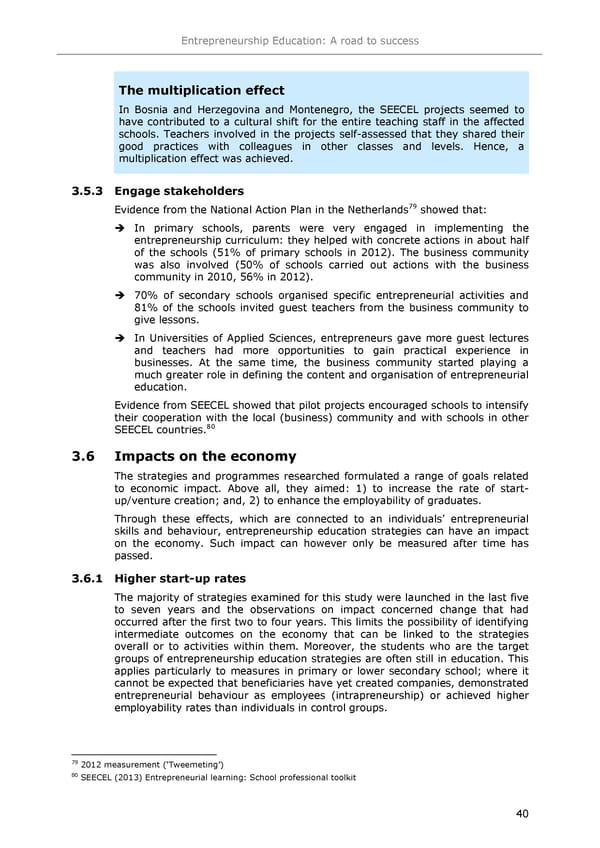Entrepreneurship Education: A road to success The multiplication effect In Bosnia and Herzegovina and Montenegro, the SEECEL projects seemed to have contributed to a cultural shift for the entire teaching staff in the affected schools. Teachers involved in the projects self-assessed that they shared their good practices with colleagues in other classes and levels. Hence, a multiplication effect was achieved. 3.5.3 Engage stakeholders Evidence from the National Action Plan in the Netherlands79 showed that: In primary schools, parents were very engaged in implementing the entrepreneurship curriculum: they helped with concrete actions in about half of the schools (51% of primary schools in 2012). The business community was also involved (50% of schools carried out actions with the business community in 2010, 56% in 2012). 70% of secondary schools organised specific entrepreneurial activities and 81% of the schools invited guest teachers from the business community to give lessons. In Universities of Applied Sciences, entrepreneurs gave more guest lectures and teachers had more opportunities to gain practical experience in businesses. At the same time, the business community started playing a much greater role in defining the content and organisation of entrepreneurial education. Evidence from SEECEL showed that pilot projects encouraged schools to intensify their cooperation with the local (business) community and with schools in other SEECEL countries.80 3.6 Impacts on the economy The strategies and programmes researched formulated a range of goals related to economic impact. Above all, they aimed: 1) to increase the rate of start- up/venture creation; and, 2) to enhance the employability of graduates. Through these effects, which are connected to an individuals9 entrepreneurial skills and behaviour, entrepreneurship education strategies can have an impact on the economy. Such impact can however only be measured after time has passed. 3.6.1 Higher start-up rates The majority of strategies examined for this study were launched in the last five to seven years and the observations on impact concerned change that had occurred after the first two to four years. This limits the possibility of identifying intermediate outcomes on the economy that can be linked to the strategies overall or to activities within them. Moreover, the students who are the target groups of entrepreneurship education strategies are often still in education. This applies particularly to measures in primary or lower secondary school; where it cannot be expected that beneficiaries have yet created companies, demonstrated entrepreneurial behaviour as employees (intrapreneurship) or achieved higher employability rates than individuals in control groups. 79 2012 measurement (8Tweemeting9) 80 SEECEL (2013) Entrepreneurial learning: School professional toolkit 40
 Entrepreneurship Education Page 43 Page 45
Entrepreneurship Education Page 43 Page 45